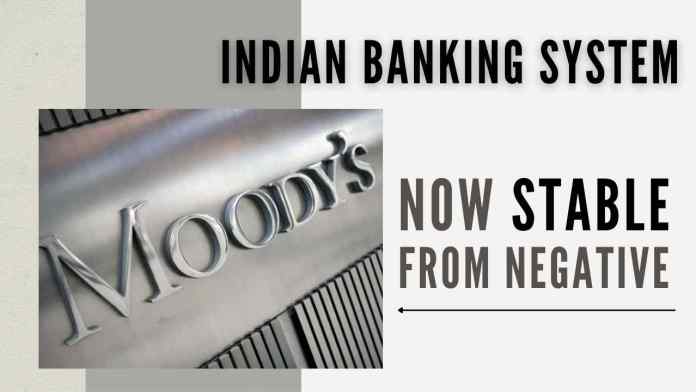
Moody’s Corporation revises outlook for Indian banking system to stable from negative
American business and financial services company, Moody’s Corporation, has revised the outlook for the Indian banking system to stable from negative, suggesting that the deterioration of asset quality since the onset of the Coronavirus pandemic has been moderate and an improving operating environment will support asset quality.
In its banking system outlook, Moody’s Investors Service is hopeful that India’s economy will continue to recover in the next 12-18 months with GDP growing 9.3 percent in the fiscal year ending March 2022 and 7.9 percent in the following year.
“The pickup in economic activity will drive credit growth, which we expect to be 10-13 percent annually. Moreover, weak corporate financials and funding constraints at finance companies have been key negative factors for banks but these risks have receded,” it said.
The basis of Moody’s revision of outlook for the Indian banking system has been the limited impact that the pandemic has on the deterioration of asset quality of banks despite relatively limited regulatory support for borrowers. The quality of corporate loans has improved, indicating that banks have recognized and provisioned for all legacy problem loans in this segment. The quality of retail loans has deteriorated, but to a limited degree because large-scale job losses have not occurred.
“We expect asset quality will further improve, leading to declining in credit costs, as economic activity normalizes,” Moody’s banking system outlook said.
The rating agency said that capital ratios have risen across rated banks in the past year because most have issued new shares. Public sector banks’ ability to raise equity capital from the market is particularly credit positive because it reduces their dependence on the government for capital. However, further increase in capital will be limited because banks will use most of the retained earnings to support an acceleration of loan growth.
The outlook has further said that the profitability of banks will improve as loan-loss provisions decline. Banks’ returns on assets will rise as credit costs will decline while banks’ core profitability will be stable. If interest rates rise, net interest margins will increase, but it will also lead to mark-to-market losses on banks’ large holdings of government securities.
Besides, funding and liquidity will be stable for both public and private sector banks. The former enjoy public trust because of sovereign backing, while the latter has stable credit profiles and strong deposit franchises.
Moody’s said that it expects Government support to remain strong for rated public sector banks, given their strong links to the government. For private sector banks, Moody’s determines the level of government support taking into account each bank’s systemic importance.
[With Inputs from IANS]
PGurus is now on Telegram. Click here to join our channel and stay updated with all the latest news and views
For all the latest updates, download PGurus App.
- PM Modi’s scathing attack in Bihar rally: Explosions in Pak kept Congress royal family awake - November 2, 2025
- JD(U)’s Anant Singh arrested in Jan Suraaj worker’s murder case - November 2, 2025
- DRI seizes Rs. 47 crore worth of cocaine from woman arriving from Colombo at Mumbai airport - November 1, 2025










